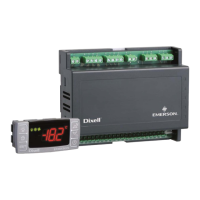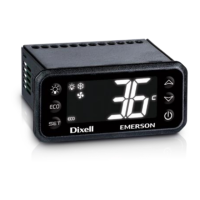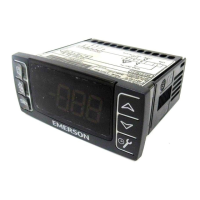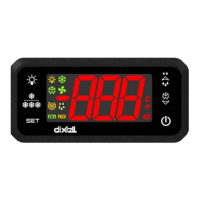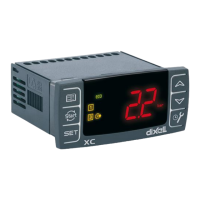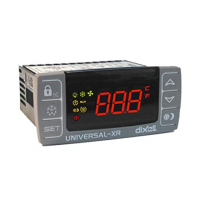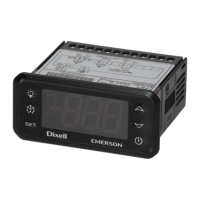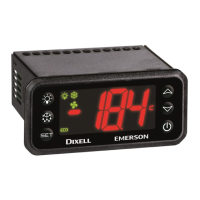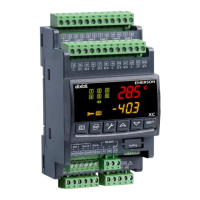15. CONTROLLING LOADS
15.1 THE SOLENOID VALVE
The regulation is performed according to the temperature measured by the thermostat probe that can be
physical probe or virtual probe obtained by a weighted average between two probes (see parameters
table description) with a positive differential from the set point. If the temperature increases and reaches
set point plus differential the solenoid valve is opened and then it is closed when the temperature reaches
the set point value again.
In case of fault in the thermostat probe the opening and closing time of solenoid valve is configured by
“Con” and “CoF” parameters.
15.2 STANDARD REGULATION AND CONTINUOUS REGULATION
The regulation can be performed in two ways: the goal of the first way (standard regulation) is reaching
the best superheat via a classic temperature regulation obtained using hysteresis. The second way,
permits to use the valve to realise an high performance temperature regulation with a good factor of
superheat precision. This second possibility, it can be used only in centralized plants and it is
available only with electronic expansion valve by selecting CrE=Y parameter.
In any case, the regulation is performed via PI regulator that gives the opening percentage to the valve
via PWM modulation explained as follow. Opening percentage is obtained from average of Opening Time
respect to CyP time period like following diagram:
With opening percentage we mean percentage of cycle period where valve is open. For example, if
CyP=6s (standard value) by saying: “The valve is opened at 50%”; this means that the valve is opened
for 3s during cycle period.
First kind of regulation:
In this case, the Hy parameter is the differential for standard ON/OFF regulation. In this case the int
parameter is neglected. The regulation follow this diagram:
Second kind of regulation – Continuous regulation (only XM679K):
In this case, the Hy parameter is the proportional band of PI in charge of room temperature regulation and
we advise to used at least Hy=5.0°C/10°F. The int parameter is the integral time of the same PI regulator.
Increasing int parameter the PI regulator become slow in reaction and of course is true vice versa. To
disable the integral part of regulation you should set int=0.
15.3 DEFROST
Defrost starting
In any case, the device check the temperature read by configured defrost probe before starting
defrost procedure, after that:
- (If RTC is present)Two defrost modes are available through the “tdF” parameter: defrost with electrical
heater and hot gas defrost. The defrost interval is controlled by parameter “EdF”: (EdF = rtc) defrost is
made in real time depending on the hours set in the parameters Ld1..Ld6 in workdays and in Sd1…Sd6
on holidays; (EdF = in) the defrost is made every “IdF” time;
- defrost cycle starting can be operated locally (manual activation by means of the keyboard or digital
input or end of interval time) or the command can come from the Master defrost unit of the LAN. In this
case the controller will operate the defrost cycle following the parameters it has programmed but, at
the end of the drip time, will wait that all the other controllers of the LAN finish their defrost cycle before
to re-start the normal regulation of the temperature according to dEM parameter;
- Every time any of the controller of the LAN begin a defrost cycle it issue the command into the network
making all the other controllers start their own cycle. This allows a perfect synchronisation of the defrost
in the whole multiplexed cabinet according to LMd parameter;
- Selecting dPA and dPb probes and by changing the dtP and ddP parameters the defrost can be started
when the difference between dPA and dPb probes is lower than dtP for all ddP time. This is useful to
start defrost when a low thermal exchange is detected. If ddP=0 this function is disabled;
Defrost ending
- When defrost is started via rtc, the maximum duration of defrost is obtained from Md parameter and
the defrost end temperature is obtained from dtE parameter (and dtS if two defrost probes are
selected).
- If dPA and dPb are present and d2P=y the instrument stops the defrost procedure when dPA is higher
than dtE temperature and dPb is higher than dtS temperature;
At the end of defrost the drip time is controlled through the “Fdt” parameter.
15.4 FANS
CONTROL WITH RELAY
The fan control mode is selected by means of the “FnC” parameter:
C-n = running with the solenoid valve, OFF during the defrost;
C-y = running with th1e solenoid valve, ON during the defrost;
O-n = continuous mode, OFF during the defrost;
O-y = continuous mode, ON during the defrost;
An additional parameter “FSt” provides the setting of temperature, detected by the evaporator probe,
above which the fans are always OFF. This can be used to make sure circulation of air only if his
temperature is lower than set in “FSt”.
CONTROL WITH ANALOG OUTPUT (if present)
In case of P4 error or if P4 is absent the output is at AMA value for the AMt time then the output is at 0 value for
the time [255 – AMt] time performing a simple PWM modulation.
15.6 AUXILIARY OUTPUT
The auxiliary output is switch ON and OFF by means of the corresponding digital input or by pressing and releasing
the down arrow key.
16. PARAMETER LIST
REGULATION
Set Temperature set point (LS÷US)
rtC Access to CLOCK submenu (if present);
EEU Access to EEV submenu (only XM679K);
Hy Differential: (0,1÷25,5°C; 1÷45°F): Intervention differential for set point, always positive.
Solenoid valve Cut IN is Set Point Plus Differential (Hy). Solenoid valve Cut OUT is when the
temperature reaches the set point.
Int Integral time for room temperature regulation (Only XM679K): (0 ÷ 255 s) integral time for
room temperature PI regulator. 0= no integral action;

